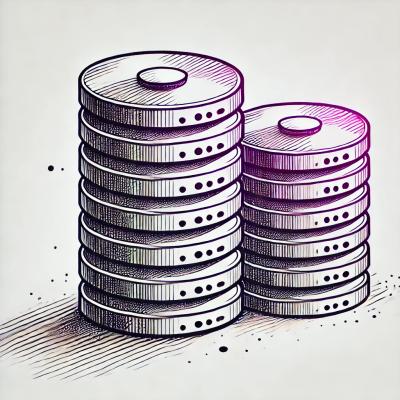
Security News
MCP Community Begins Work on Official MCP Metaregistry
The MCP community is launching an official registry to standardize AI tool discovery and let agents dynamically find and install MCP servers.
nft-did-resolver
Advanced tools
NFT is a DID method that uses the Ceramic network to resolve DID documents for NFTs
See CIP-94
This implementation is still a prototype. Contributions are welcome!
To use a package, you would need to provide three subgraph endpoints for every network you are going to use:
one for blocks, one for ERC721 tokens, another for ERC1155 tokens. You would also need to provide a skew that
is a time (in milliseconds) within which a latest block is considered valid. Usually it is a typical block time.
$ npm install nft-did-resolver
import { getResolver } from 'nft-did-resolver'
import type { NftResolverConfig } from 'nft-did-resolver'
import { Resolver } from 'did-resolver'
import Ceramic from '@ceramicnetwork/http-client'
const ceramic = new Ceramic() // connects to localhost:7007 by default
const config: NftResolverConfig = {
ceramic,
chains: {
'eip155:1': {
blocks: 'https://api.thegraph.com/subgraphs/name/yyong1010/ethereumblocks',
skew: 15000,
assets: {
erc721: 'https://api.thegraph.com/subgraphs/name/sunguru98/mainnet-erc721-subgraph',
erc1155: 'https://api.thegraph.com/subgraphs/name/sunguru98/mainnet-erc1155-subgraph',
},
},
'eip155:4': {
blocks: 'https://api.thegraph.com/subgraphs/name/mul53/rinkeby-blocks',
skew: 15000,
assets: {
erc721: 'https://api.thegraph.com/subgraphs/name/sunguru98/erc721-rinkeby-subgraph',
erc1155: 'https://api.thegraph.com/subgraphs/name/sunguru98/erc1155-rinkeby-subgraph',
},
},
},
}
// getResolver will return an object with a key/value pair of { 'nft': resolver }
// where resolver is a function used by the generic did resolver.
const nftResolver = getResolver(config)
const didResolver = Resolver(nftResolver)
const erc721result = await didResolver.resolve(
'did:nft:eip155:1_erc721:0xb300a43751601bd54ffee7de35929537b28e1488_2'
)
const erc1155result = await didResolver.resolve(
'did:nft:eip155:1_erc1155:0x06eb48572a2ef9a3b230d69ca731330793b65bdc_1'
)
console.log(erc721result, erc1155result)
chains field in config has CAIP-2 chain identifiers as keys.
Each such chain is expected to contain endpoints to ERC721 and/or ERC1155 subgraphs under assets field.
Both ERC721 and ERC1155 are supported. Feel free to specify either one or both.
The resolver supports the following networks by default:
eip155:1),eip155:4),eip155:137).If you use one of those, you do not have to provide chains field.
$ npm test
You may specify custom subgraph URLs in the configuration object as shown above in usage.
Note: custom subgraphs must conform to the below schemas at a minimum for assets to be resolved properly.
Note: At the moment, only ERC721 and ERC1155 asset namespaces are supported. However, CAIP2 chains beside ETH, for instance xDAI, with support for those namespaces are supported, as long as the subgraph schema is the same.
type Token @entity {
id: ID!
contract: TokenContract!
owner: Owner!
...
}
type TokenContract @entity {
id: ID!
tokens: [Token!]! @derivedFrom(field: "contract")
...
}
type Owner @entity {
id: ID!
tokens: [Token!]! @derivedFrom(field: "owner")
...
}
type Account @entity {
id: ID!
balances: [Balance!]! @derivedFrom(field: "account")
...
}
type TokenRegistry @entity {
id: ID!
tokens: [Token!]! @derivedFrom(field: "registry")
...
}
type Token @entity {
id: ID!
registry: TokenRegistry!
identifier: BigInt!
balances: [Balance!]! @derivedFrom(field: "token")
...
}
type Balance @entity {
id: ID!
token: Token!
account: Account!
...
}
For more information on writing schemas for GraphProtocol, check out their documentation.
The token DIDs are prefixed with did:nft:, and the latter half is a modified CAIP format.
ERC721 (CAIP-22)
DID: did:nft:{chainNamespace}:{chainReference}_erc721:{contractAddress}_{tokenId}
CAIP-22: {chainNamespace}:{chainReference}/erc721:{contractAddress}/{tokenId}
ERC1155 (CAIP-29)
DID: did:nft:{chainNamespace}:{chainReference}_erc1155:{contractAddress}_{tokenId}
CAIP-29: {chainNamespace}:{chainReference}/erc1155:{contractAddress}/{tokenId}
DID->CAIP
const caip = did.substr(8).replace(/_/g, '/')
CAIP->DID
const did = `did:nft:${caip.replace(/\//g, '_')
There are helpers that help you with the conversion:
import { caipToDid, didToCaip, createNftDidUrl } from 'nft-did-resolver'
import { AssetId } from 'caip'
// CAIP -> DID URL
const didUrl = createNftDidUrl({
chainId: 'eip155:1',
namespace: 'erc721',
contract: '0x1234567891234567891234567891234596351156'
tokenId: '1',
})
// If you use `caip` library in your app, consider using sister `caipToDid` function to convert `AssetId` to NFT DID URL.
// DID URL -> CAIP
const assetId1 = didToCaip(didUrl) // eip155:1/erc721:0x1234567891234567891234567891234596351156/1
const assetId2 = didToCaip(didUrlWithTimestamp) // eip155:1/erc721:0x1234567891234567891234567891234596351156/1
We are happy to accept small and large contributions. Make sure to check out the Ceramic specifications for details of how the protocol works.
Apache-2.0 OR MIT
FAQs
DID Resolver for the NFT method
The npm package nft-did-resolver receives a total of 489 weekly downloads. As such, nft-did-resolver popularity was classified as not popular.
We found that nft-did-resolver demonstrated a not healthy version release cadence and project activity because the last version was released a year ago. It has 2 open source maintainers collaborating on the project.
Did you know?

Socket for GitHub automatically highlights issues in each pull request and monitors the health of all your open source dependencies. Discover the contents of your packages and block harmful activity before you install or update your dependencies.

Security News
The MCP community is launching an official registry to standardize AI tool discovery and let agents dynamically find and install MCP servers.

Research
Security News
Socket uncovers an npm Trojan stealing crypto wallets and BullX credentials via obfuscated code and Telegram exfiltration.

Research
Security News
Malicious npm packages posing as developer tools target macOS Cursor IDE users, stealing credentials and modifying files to gain persistent backdoor access.